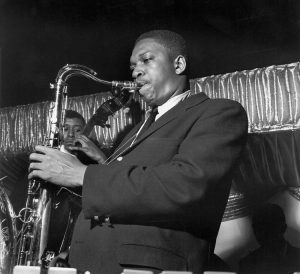It’s a common dilemma – when faced with the catalogue of a 20th century musical giant, where should the uninitiated start? In John Coltrane’s case, one could do a lot worse than “Live at Birdland”, released in January 1964 on the Impulse! label.
Featuring the members of his fabled quartet – McCoy Tyner on piano, Jimmy Garrison on bass, Elvin Jones on drums – it was the final recording of an important and busy year in the saxophonist’s musical life. He was gaining an ever younger fanbase drawn from university campuses and music schools. In the meantime, in a remarkably consistent era for Impulse!, producer Bob Thiele knew to strike while the iron was hot, and Coltrane was given almost carte blanche to record anything he wanted during 1963.
Coltrane’s first studio project of the year was released in 2018 as “Both Directions At Once”, taped at Rudy Van Gelder’s Englewood Cliffs studio on March 6. The very next day, “John Coltrane and Johnny Hartman” was recorded, a delicious riposte to John’s critics and a masterpiece of jazz balladry (Hartman would go on to record two further solo albums for Impulse!).

John Coltrane Both Directions At Once
Available to purchase from our US store.Summer 1963 then saw a few upheavals. Jones spent three months in a drug rehabilitation centre in Lexington, Kentucky, between May and August (Coltrane tried out various drummers during this time, with Roy Haynes recording the famous take of “My Favorite Things” at the Newport Jazz Festival on July 7, immortalised on “Newport ‘63”). Coltrane also finally left his first wife Naima.
Then, during the morning of Sunday September 15, a dozen sticks of dynamite were planted in the basement of the 16th Street Baptist church in Birmingham, Alabama. Four black girls – Addie Mae Collins, Carole Robertson, Cynthia Wesley and Denise McNair – were killed in the racist attack, and a desolate Coltrane responded in the only way he knew how. The chilling, remarkable “Alabama”, recorded at Van Gelder’s studio on November 18, was as powerful in its way as “Strange Fruit”.
According to Tyner, Coltrane’s inspiration for the piece were Martin Luther King’s speech patterns during his famous eulogy spoken three days after the bombing. “Alabama” found itself tagged on to “Live at Birdland” alongside another studio piece, the sprightly “Your Lady”, a love letter to his soon-to-be second wife, Alice.

But “Live at Birdland” was predominantly recorded on October 8 during Coltrane’s third engagement of the year at the famous Manhattan club. The album was essentially a remarkable explosion of energy. Two quintessential Coltrane waltzes – “Afro Blue” and “The Promise” – showcased his coruscating soprano sax alongside some essential Tyner piano breaks, while the tender “I Want To Talk About You” featured Coltrane’s famous closing three-minute cadenza.
Even the famously curmudgeonly Philip Larkin enjoyed “Live at Birdland”. The liner notes by a certain LeRoi Jones, who would change his name to Amiri Baraka soon after, only added to its mystique. Coltrane set off on a European tour after its recording and wouldn’t return to the studio until summer 1964. That would be yet another epochal year for lovers of his music.

John Coltrane 1963: New Directions
Available to purchase from our US store.Matt Phillips is a London-based writer and musician whose work has appeared in Jazzwise, Classic Pop, Record Collector and The Oldie. He’s the author of “John McLaughlin: From Miles & Mahavishnu To The 4th Dimension”.
Header image: John Coltrane performs onstage at Birdland in 1955 in New York. Photo: PoPsie Randolph/Michael Ochs Archives/Getty Images.


